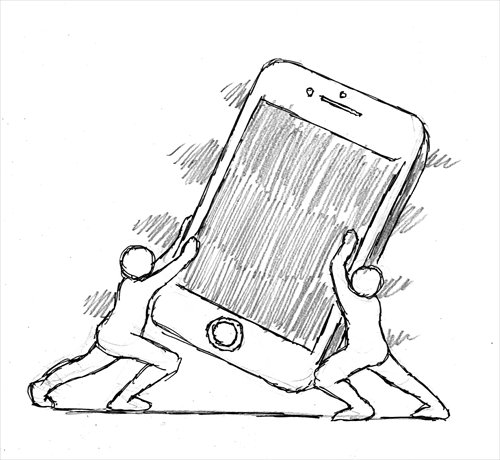


Illustration: Peter C. Espina/GT
After reading the just released report by the US-China Business Council, those who believe China and the US are coming close to a "tipping point" might have to think twice.
The report gives a glimpse of the high-level integration of China and the US. Since it began reform and opened its borders to foreign goods and services 37 years ago, China has been benefiting a lot from a growing trade with the US, and vice versa. Even though China now faces an economic downturn, it is still an important export market for US-made goods and services, and continues to contribute to the growth of the US economy.
Last year saw US exports to China totaled to record $120.8 billion. Compared with other major US trading partners, US exports to China have grown fastest. It increased 198 percent during 2005 to 2014.
It is trade that has changed the world, and it runs through the entire epic of human history. Trade has triggered many historic events and bridges different groups by boosting cultural, technological and people-to-people communication.
A colossal trade volume between two major powers whose political systems and traditional cultures are so different is unprecedented. Therefore, it may contain power beyond anyone's expectations.
At the initial stage of China's reform and opening-up, US strategists hoped China would open itself more and head to where the US had pointed. Business and trade were regarded as a leading force which would drag China into a US-dominated system.
Now, the US becomes a major beneficiary of China's rise, but the path China has taken has been quite different from what these US pundits wished. Disappointed at the trajectory, they have inferred that China might collapse, or engage in physical confrontations with the US.
Business and trade should take the credit of China's rapid development. It also changed the way China looks at the US. Today, these strong-headed Americans who insist on thinking this way may need to review their understandings about US-China relations from the perspective of bilateral trade.
More than 30 years ago, a relative of mine living in the US gave me a ball-pen with a small electronic watch attached. I carried it in my shirt pocket. That is the first "made in USA" product I have ever used. Now, millions of Chinese consumers are taking the iPhone and iPad with them every day. Meanwhile, China-made products are offering life convenience to millions of American families.
Business and trade has become the ballast of Sino-US relations. It has greatly boosted people-to-people exchanges. But there are more implications.
Sino-US trade has long surpassed the initial phase which features simple transactions. They have become a powerful group bound by vested interests. The components of this group are very complicated. It includes investments by international corporations where both countries are involved, joint research and development, co-manufacturing of product accessories and the connection of industrial chains.
A lot of goods and services in the international market are not 100 percent made in China or the US. No part of the Coca-Cola you drink in China comes from the US except the brand. This kind of mix-and-match is becoming commonplace.
When conflicts emerge in the future, the boundaries around China's interests and US interests will become vague. Beijing and Washington are going to deal with matters that integrate the interests of both sides.
The blend of interests will probably induce new types of trade frictions, but it can ensure the bilateral relationship won't be derailed, because the costs are piling up along with the expansion of Sino-US trade relationship. The development of Sino-US trade will make the Americans understand that US long-term interests can be better fostered if it allows China to opt for its own path.
 Beautiful and smart - post-90s college teacher goes viral
Beautiful and smart - post-90s college teacher goes viral Students take graduation photos in ancient costumes
Students take graduation photos in ancient costumes Forbidden City collects evidence from nude photo shoot
Forbidden City collects evidence from nude photo shoot Chinese students learn Duanwu customs in Hefei, Anhui
Chinese students learn Duanwu customs in Hefei, Anhui Abandoned village swallowed by nature
Abandoned village swallowed by nature Graduation: the time to show beauty in strength
Graduation: the time to show beauty in strength Top 16 Chinese cities with the best air quality in 2014
Top 16 Chinese cities with the best air quality in 2014 Mysterious “sky road” in Mount Dawagengzha
Mysterious “sky road” in Mount Dawagengzha Dragon boat race held to celebrate upcoming Duanwu Festival
Dragon boat race held to celebrate upcoming Duanwu Festival  Military parade to send message of peace
Military parade to send message of peace Dog lover rescues Yulin pups and cats
Dog lover rescues Yulin pups and cats FAW strives to develop its own line of vehicles
FAW strives to develop its own line of vehicles African legal professionals study in China due to closer business ties
African legal professionals study in China due to closer business tiesDay|Week